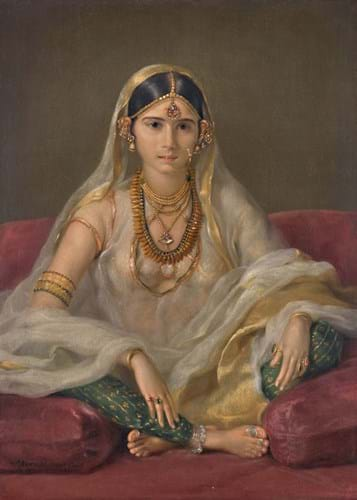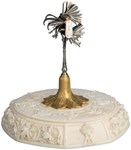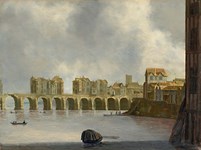Looking at the best individual performers at the latest Old Master auction series in London, it seems an increasing gulf in demand is emerging between the remarkable and unremarkable.
Although at times the sales in December felt quite flat, especially when more run-of-the-mill offerings came to the auction block, works with either a special subject or quirky appeal fared much better and sold at levels way beyond what they would probably have made 20 years ago.
The two paintings that drew the most competition at the flagships sales at Sotheby’s and Christie’s were both examples of this, generating a level of interest that contrasted to the tepid bidding elsewhere, even on the much-publicised headline lots.
Scarce work
Sotheby’s Old Master evening sale on December 6 was led by a reattributed Rembrandt study that sold at £9.5m (see ATG No 2622).
While much of the media attention focused on the fact that it netted a huge return for the vendor (reportedly a London dealer) who bought it as ‘circle of Rembrandt’ two years ago at an online sale at Christie’s Amsterdam, seemingly all bar one of the potential bidders baulked at the £10m-15m estimate which looked somewhat hefty for a small monochromatic panel, even one by the great Dutch master.
Instead the night belonged to Francesco Renaldi (1755-after 1798) when a rare and lustrous portrait of a Mughal lady clearly captured the imagination of multiple parties. It more than tripled the auction record for the artist.
Any work by Renaldi (who was born in England to Italian parents) is scarce on the market – Artprice.com records just seven results.
This is especially so with his Orientalist subjects which were painted on a 10-year spell in India between from 1786-96.
Indeed, the portrait here dated from 1787 and was made during an even shorter window – a highly productive period when the artist was based in Calcutta from 1786 until 1789. During this time he painted Muslim Lady Reclining, one of his most famous paintings, which is now in the Yale Center for British Art.
The portrait here had not been on the market since the vendor acquired it at Sotheby’s back in 1969.
The 3ft 3in x 2ft 4in (1m x 72cm) signed oil on canvas showed the young sitter festooned in jewellery, including an extraordinary champakali in the form of jasmine bud, a gold nose-ring and elaborate headpiece.
Another version of the portrait, showing the same sitter in a similar pose but with the addition of a hookah pipe and a silver perfume bottle, emerged at Christie’s back in 1988, making £190,000 and setting a benchmark for Renaldi at auction that stood until the current sale.
The Sotheby’s catalogue suggested that the sitter was part of the entourage at one of the Mughal embassies in Calcutta, which at this time was the centre of the British East India Company’s administration.
The picture had a huge amount going for it commercially – not least the attractive subject and striking composition which showed the sitter seated cross-legged in a red interior but with the upper section of the canvas set against a plain background.
Added to the rarity and market freshness, the £300,000-500,000 estimate at Sotheby’s did not deter interest even though some parties may have felt it was toward the upper end for what ultimately was a piece of English Orientalism.
At the sale it drew five phone bidders and was knocked down at £650,000 to a buyer bidding through Sotheby’s New York-based co-Chairman of Old Master paintings George Wachter.
The sum was another major benchmark for Renaldi and it will be interesting to see if the market will have to wait another 35 years before another such work appears.
Sweerts in demand
Christie’s Old Masters part 1 sale held the following day had a similar story in terms of the top lot bringing limited interest but some good action elsewhere.
A pair of Venetian scenes by Canaletto (1697-1768) led the sale, selling at £8.2m against a £8m-12m pitch. While such images are highly familiar in the artist’s canon and these examples were smaller-scale than some of his famous depictions of the Grand Canal and Doge’s Palace, a more intense battle came for a more unusual work by Flemish painter Michael Sweerts (1618-64).
The 17¾ x 13½in (45 x 34cm) oil on canvas was thought to depict the artist himself presenting a painting of the Virgin in prayer.

A work by Michael Sweerts thought to be a self-portrait of the artist with a depiction of the Virgin in prayer. It sold for £1.4m at Christie’s.
It was described in the catalogue as a ‘unique work’ with the ingenious trompe l’oeil technique demonstrating why Sweerts is increasing seen as such ‘an enigmatic and hauntingly memorable artist’.
While Sweerts is another name that is rare to see at auction, this was the second time this year that a significant rediscovery of one of his works had emerged at Christie’s King Street rooms.
A much larger example was the highlight of the summer Old Master series when The Artist’s Studio with a Seamstress made a record £10.7m in July – raising the bar for the Baroque painter almost five-fold.
The work here may well have been unearthed thanks to that result. It came from a private Austrian vendor who had inherited it and in whose family it had resided since at least the first half of the 20th century.
Attracting bidding from both the room and on the phone, it flew over a £400,000-600,000 pitch and was knocked down at £1.4m to a member of the trade who was sitting in the front row of the saleroom.
Buyer’s premiums
Sotheby’s: 26/20/13.9% + 1% overhead premium
Christie’s: 26/21/15%















